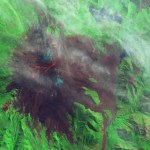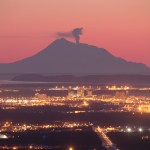mitigation
Llaima in Chile, taken on April 9, 2009. Image courtesy of the NASA Earth Observatory.
The NASA Earth Observatory (currently celebrating its 10th year) has posted a number of great images of the current eruption of Llaima in Chile, taken from Earth Observing-1 and Terra Satellites. They show both the ash plume of the eruption and the lava flows associated with it (above). The image here is a false-color image of Llaima, where the bright red/orange is the lava flow from the volcano, along with the dark brown of the ash/rocks from this and previous eruptions.
The eruption itself might continue…
Llaima erupting at night in April 2009.
Brief update for those of you following the somewhat spectacular eruption (above and below) going on at Llaima in Chile. The latest reports indicate the eruption is waning (in spanish) with less ash and explosions (in spanish) being produced. However, ONEMI, the Chilean Emergency Office, continues to keep the area on alert. So far, at least 81 people have been evacuated (in spanish) during the eruptions that gained strength over the weekend and flights between Buenos Aires and Neuquén were suspended due to the ash.
It is interesting to note the…
Image courtesy of AVO/USGS taken by Kristi Wallace showing the eruption plume on March 31, 2009.
Today's update will be relatively brief: AVO has returned Redoubt to Orange/Watch status after this weekend's eruptions. The new dome continues to grow and this is accompanied by the usual volcanic seismicity associated with dome construction. We should expect to see the status fluctuate from Orange to Red as the eruption waxes and wanes - and likely get little to no warning of the next big explosive event.
The eruptions of Redoubt has forced Chevron to halt activity for all its Cook Inlet oil…
Ulawun Volcano, Papau New Guinea, one of the "Decade Volcanoes"
There was some discussion earlier about the so-called "Decade Volcanoes", so I thought I'd elaborate a bit on them (doubly so in light of certain other lists.) These volcanoes are defined by IAVCEI - the International Association of Volcanology and the Chemistry of the Earth's Interior - and are part of a program whose aim is
"to direct attention to a small number of selected, active volcanoes world-wide and to encourage the establishment of a range of research and public-awareness activities aimed at enhancing an…
Llaima erupting in April 2009.
Just a quick note about the eruption currently ongoing at Llaima in Chile. The volcano continues to explosively (and effusively) erupt, sending ash ~22,000 feet / 7,000 meters into the air. This eruption has produced 37 hours of intense eruption (in spanish) so far and the ash from the eruption is drifting into Argentina, almost 100 km to the SE of the volcano. More evacuations are being called for by ONEMI and so far 71 people have left the vicinity of the volcano due to fears of lahars and significant ash fall (In spanish, but it does provide video of the…
Image courtesy of AVO/USGS by James Isaak. Photo taken 3/31/2009.
No, this isn't Battlestar Galactica, but the same can be said for the Drift River Oil Terminal: this has all happened before and will all happen again. Coast Guard officials have (finally) decided to move ~6.3 million gallons of crude oil from the Chevron-owned Drift River Oil Terminal at the base of Redoubt. The oil terminal has been a flashpoint since Redoubt began to make noise earlier this year and even up until yesterday, it was unclear what, if any, action the Coast Guard might take with the facility. It had been shut…
Goma after the 2002 Eruption of Nyiragongo
The activity at Redoubt has captivated a lot of us, but in the grand scheme of things, its eruption are more likely to caused inconvenience and property damage rather than dramatically loss of life (unless something huge and unexpected occurs). However, the same cannot be said if Nyiragongo and/or Nyamuragira (a.k.a. Nyamulagira) in the Congo were to erupt. These volcanoes are close to the city of Goma, a city of nearly 600,000, not including refugees from the fighting in the region. Eruptions of Nyiragongo in 2002 prompted the displacement of 400,…
Image courtesy of AVO/USGS by Tricia Joy Sadler. Taken 3/28/2009 at 3:29 PM
Redoubt did not stray from its pattern of explosive eruptions producing >20,000 foot / 10,000 meter ash columns over the weekend. However, what did change was the wind, and because of that, Anchorage began to feel the effects of the volcano. Ash prompted the closure of Ted Stevens International Airport in Anchorage for 22 hours on Saturday and Sunday. The airports near Redoubt are still experiencing delays and closure due to ash - remember, remobilized ash can be a problem as well, but many have reopened after ash…
Image courtesy of AVO/USGS by Ron Beck. Shows an ash plume from Redoubt (tan) on March 26 from a Landsat 5 satellite.
I'll be "off the grid" for the weekend at a wedding, so I thought I'd leave this open for any Redoubt news Eruptions readers hear over the weekend. Feel free to leave comments about the developments up in Alaska.
Currently, AVO reports that seismicity is lower since the eruptions this morning. They indicate that eruptions will likely occur without warning from here on in.
There are also some new articles on how the eruption is affecting air travel, including cancellations of…
Redoubt seems to be setting its pattern for this part of the new eruptive period. There was another small explosion this morning that produced at 15,000 foot / 5,000 meter ash column that moved to the NNW. The seismicity has settled down since the early morning eruption today (3/25) as well.
These types of explosions producing plinian and subplinian eruption clouds that will likely lead to dome building - the same pattern seen at Mt. Saint Helens in 2004-2008 and the previous Redoubt eruptions in 1989-1990. These explosions, producing ash columns that reach tens of thousands feet, will likely…
Mauna Loa fire fountains in 1984
For those of you looking for some non-Redoubt-related volcano news, you can take a look at the 25th anniversary of the last eruption at Mauna Loa (there is some nice video footage provided by KHNL if you follow the link). By no means is this volcano "dormant", but rather this is a typical lull in activity at the Hawaiian shield volcano. Its neighbor, Kilauea, has been erupting for decades, but the last major eruption at Mauna Loa was in 1984, when the volcano sent lava downslope with 3,000 feet of Hilo, moving 15 miles in a few days. Monitoring at Mauna Loa…
Image by AVO/USGS/Game McGimsey, March 23, 2009
Redoubt has simmered down some today with no new eruptions since yesterday evening. AVO's field crew not only fixed the Hut webcam, but also spotted massive lahar deposits (see above) in the Drift River valley that traveled 35 kilometers downstream and have officials on local and national levels worried about the Drift River Oil Terminal. Funny, it sounds so familiar somehow? As usual, an ounce of planning and thought about locating an oil terminal at the foot of an active volcano would have prevented about 10 tons of problems now.
AVO will be…
Image courtesy of AVO/USGS
AVO has posted a series of images taken around Redoubt and around the Cook Inlet since the new eruptions started the night of March 22nd. You can begin to see the extent of the ash fall, what the explosions have done to the Drift Glacier and the new deposits in the Drift River valley. Most of the images show a lot of meltwater mudflows and tephra deposits on the slopes of the volcano. They've also added images from satellite and radar sources that show the initial dispersal of ash from the eruptions throughout the area north of Redoubt.
Eruptions reader Akira…
The Anchorage Daily News has a report that 16 Alaskan representatives got stuck in Anchorage after the eruption started. They were headed to Juneau to vote on Alaska accepting stimulus money ("volcano monitoring" anyone?), but they were on one of the many flights canceled by Alaska Airlines today due to the ash. ADN also have reports of an "ash out" in the coastal town of Skwentna.
AVO is currently reporting that ash doesn't appear on the current radar maps in the Cook Inlet and there are no reports of new ash fall. This suggests that the ash is either staying below 13,000 feet / 4,000…
Redoubt on 3/15/2009, from Eagle River overlooking Anchorage. Photo courtesy of Calvin Hall
I'm breaking this out of the comments of the "Redoubt Erupts!" post just to keep things up-to-date.
As of now, we know:
At least 5 explosions have occurred as part of the eruption
Ash has drifted to the NNE and W - both as seen on radar and as reports of ash falling in Skwentna and the Chuitna area - and so far missing populated areas (see above)
The ash cloud is believe to have reached as high as 50,000 feet/15,000 meters - prompting an aviation warning/restrictions and cancellation of flights out…
Mt. Redoubt in March 2009, prior to erupting
At ~10:30 PM (Alaskan Time) last night, Mt. Redoubt erupted. AVO and the Anchorage VAAC issued a Red Alert for ash as high as 50,000 feet (15,000 meters) around the volcano. Information is scarce about the exact nature of the ash cloud because of the fact that the volcano erupted at night. The eruption has contained at least 5 large explosion and at least one of the seismometers at the volcano has stopped reported (RSO). An ashfall advisory has been issued by the Weather Service, with ash predicted to fall throughout the Susitna Valley (which…
So, as I am apt to do from time to time, I was wandering the interweb and stumbled across the FEMA (Federal Emergency Management Agency) for Kids website. Naturally, I thought, what do they have to say about, oh, I don't know, volcanoes. Well, was I in for a doozy!
FEMA, in its infinite wisdom, has this to say about volcanoes (for kids, mind you):
[A] volcano is a mountain that opens downward to a pool of molten rock below the surface of the earth.
Oh. My. Word ... but wait, there's more!
The ash can cause damage to the lungs of older people, babies and people with respiratory problems.
Yes…
James Hrynyshyn at Island of Doubt yesterday put up a really interesting examination of the Copenhagen Conference's efforts to deal with just what is the "safety limit" for global warming. I won't add much accept to lament the fact that "as much as possible as soon as possible" is too vague for public policy goals.
Because really, that is the only correct answer to the question politicians want scientists to answer: how much do we need to reduce CO2 emissions?
Have a read.
Oldonyo L'engai, Tanzania
As with most disasters, the best way to prevent a Katrina-like catastrophe is preparedness. The best successes in volcanic mitigation have been in places where the combination of monitoring, communications and practice fit together like so many legos in a set, allowing for a calm and orderly evacuation when the eruption, or signs of eruption, began (e.g., Rabaul in 1994). This is why it is always heartening to me to see articles about places trying to implement hazard mitigation plans for their volcanoes. Two examples are in the news today:
(1) Officials in…
I missed this the first time, but Click & Clack from NPR's Car Talk answered a question about how to volcano-proof your car.
If you want to hear it, click here. As usual, the guys in Cambridge (our fair city) do an excellent job with the information and the humor.
{Hat tip to Jen Glass at Arizona State}

